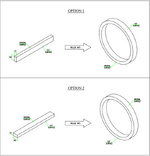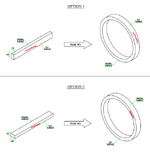Hello everyone,
I’m seeking clarification on a fabrication method for a ring-type flange with the following dimensions:
My questions:
I’m seeking clarification on a fabrication method for a ring-type flange with the following dimensions:
- I.D.: 1100 mm
- O.D.: 1250 mm
- Thickness: 135 mm (no hub)
- Material: A516-70
- Cutting 140 mm-wide strips from a 75 mm-thick plate and rolling them (so the flange axis aligns with the plate’s original surfaces), or
- Cutting a full ring directly from the 140 mm-thick plate (avoiding rolling altogether).
My questions:
- Is rolling the strip in the fabricator's proposed direction technically acceptable despite the grain orientation concern?
- If not, are there code provisions (beyond Appendix 2) or other references that explicitly address this?


